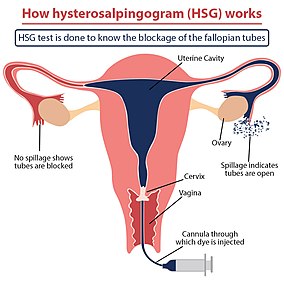
Back تصوير الرحم بالصبغة Arabic Histerosalpingografia Catalan Hysterosalpingografie Czech Histerosalpingografía Spanish رحملولهنگاری Persian Hystérographie French צילום רחם HE Isterosalpingografia Italian 子宮卵管造影検査 Japanese ہِسٹیٖروسیلپِنگوگرٛافی Kashmiri
This article has multiple issues. Please help improve it or discuss these issues on the talk page. (Learn how and when to remove these template messages)
|
| Hysterosalpingography | |
|---|---|
 A normal hysterosalpingogram. Note the catheter entering at the bottom of the screen, and the contrast medium filling the uterine cavity (small triangle in the center). | |
| Other names | Uterosalpingography |
| ICD-9-CM | 87.8 |
| MeSH | D007047 |
| MedlinePlus | 003404 |

Hysterosalpingography (HSG), also known as uterosalpingography,[1] is a radiologic procedure to investigate the shape of the uterine cavity and the shape and patency of the fallopian tubes. It is a special x-ray procedure using dye to look at the womb (uterus) and fallopian tubes.[2] In this procedure, a radio-opaque material is injected into the cervical canal, and radiographs are taken. A normal result shows the filling of the uterine cavity and the bilateral filling of the fallopian tube with the injection material. To demonstrate tubal patency, spillage of the material into the peritoneal cavity needs to be observed. Hysterosalpingography has vital role in treatment of infertility, especially in the case of fallopian tube blockage.
- ^ "Hysterosalpingography (Uterosalpingography)". RadiologyInfo. June 8, 2016.
- ^ "Hysterosalpingography: MedlinePlus Medical Encyclopedia". medlineplus.gov. Retrieved 2019-05-06.